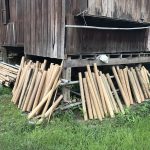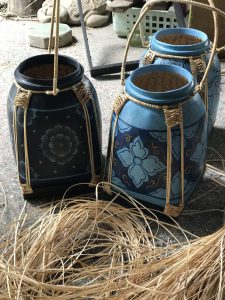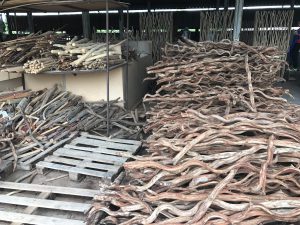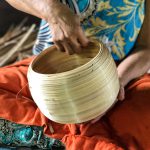At Artifactio, many of our products have been inspired not only by their unique Asian cultural heritage but also the tropical nature and its abundance of unique and naturally shaped reclaimed wood vines, roots, tree trunks and branches. We take great care that our products are made from natural & sustainable raw materials that reflect our respect for the environment and the planet. As a consequence, we work hard to ensure that all of our reclaimed wood materials come from legal sources only.
Recycled or reclaimed wood typically comes from houses, boats or other demolished constructions and are carefully hand-selected prior to assembly. Other natural materials such as teak, vines, drift wood and other forested wood types are purchased from licensed suppliers only.
These beautiful pieces of natural root, tree trunk, tree branch and wooden vine are then washed, sanded and treated to reveal the beautiful texture underneath. With skilled craftsmanship, the pieces of wood are assembled together to create one-of-a-kind decorative items.
Some of the wood types our artisans typically work in include the following:
Bamboo:

One of our favorite raw materials and of notable economic and cultural significance in Southeast Asia, bamboo is used for building materials, as a food source, and as a versatile raw product for a variety of items. One of natures most impressive raw materials, Bamboo has a higher specific compressive strength than wood, brick, or concrete and a specific tensile strength that rivals steel. The bamboo used for our selection of beautiful rice boxes for example, is harvested in Phrae, in northern Thailand.

Whilst the beautiful designs differ greatly, all our rice boxes are made from woven bamboo strips.
Driftwood:
Driftwood is quite simply wood that has been washed onto a shore or beach of a sea, lake, or river by the action of winds, tides or waves. It is an ideal and versatile raw material to create unique and striking decorative items due to its naturally washed look. Most driftwood is the remains of trees, in whole or part, that have been washed into the ocean, due to flooding, high winds, or other natural occurrences, or as the result of logging. There is also a subset of driftwood known as drift lumber. Drift lumber includes the remains of man-made wooden objects, such as buildings and their contents washed into the sea during storms. Erosion and wave action often makes it difficult or impossible to determine the origin of a particular piece of driftwood.
Vines & lianas:

Vines & lianas sourced in Southeast Asia and used in our designs.
You will see our artisans using these unusual but beautiful materials sourced naturally from the region! Liana are long-stemmed, woody vines that are rooted in the soil at ground level. They ingeniously use trees (or anything really) to get vertical support, to climb up to the forest canopy to get access to well-lit areas of the forest they otherwise could not access.
A visit to our artisans warehouses will always have a good stock of these wonderful raw materials which they use in creative and artistic ways in their designs.
Eucalyptus wood:
Another great and versatile medium to work in, Eucalyptus reclaimed wood is red to reddish-brown in color and it darkens as it ages. The grain of this tree is slightly interlocked and it has a medium to coarse texture upon touching it. Interestingly, logs have been known to lie in wet forests for 10 to 20 years without decaying!
Eucalyptus wood is used for all types of construction and is often made into flooring or objects such as bowls, and traditional decorative items. As wood types go, it is easy to saw, sand, plane and polish, and takes paint well.
Acacia wood:
Another versatile wood type our artisans use that possesses many benefits is acacia wood – in our opinion one of the best wood types for furniture! The wood is heavy, strong, and resistant to wear and tear. The beauty of the wood grains adds subtlety to any furniture or decorative items it is sued to make. When cut, the wood has a high polish, and it has a sweet smell to it.
Depending on how the wood is finished, it can look light or dark. For example, if it has a lime wash, the furniture appears smooth and the wood grain patterns are remarkable.
A final interesting titbit – Acacia wood has been around since biblical times and long before it. It’s believed that acacia wood was used to construct the Tabernacle and Ark of Covenant because it was virtually indestructible.

What might appear as junk to some becomes beautifully hand-crafted wooden products at Artifactio.com!
